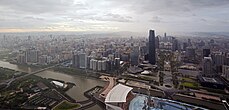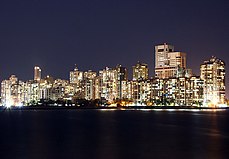Urbanization
Urbanization (or urbanisation) refers to the population shift from rural to urban areas, the corresponding decrease in the proportion of people living in rural areas, and the ways in which societies adapt to this change.[1] It is predominantly the process by which towns and cities are formed and become larger as more people begin living and working in central areas.[2]
Although the 2 concepts are sometimes used interchangeably, urbanization should be distinguished from urban growth. Urbanization refers to the proportion of the total national population living in areas classified as urban, whereas urban growth strictly refers to the absolute number of people living in those areas.[3] It is predicted that by 2050 about 64% of the developing world and 86% of the developed world will be urbanized.[4] That is equivalent to approximately 3 billion urbanites by 2050, much of which will occur in Africa and Asia.[5] Notably, the United Nations has also recently projected that nearly all global population growth from 2017 to 2030 will be by cities, with about 1.1 billion new urbanites over the next 10 years.[6]
Urbanization is relevant to a range of disciplines, including urban planning, geography, sociology, architecture, economics, education, statistics and public health. The phenomenon has been closely linked to modernization, industrialization, and the sociological process of rationalization.[7] Urbanization can be seen as a specific condition at a set time (e.g. the proportion of total population or area in cities or towns), or as an increase in that condition over time. Therefore, urbanization can be quantified either in terms of the level of urban development relative to the overall population, or as the rate at which the urban proportion of the population is increasing. Urbanization creates enormous social, economic and environmental changes, which provide an opportunity for sustainability with the "potential to use resources more efficiently, to create more sustainable land use and to protect the biodiversity of natural ecosystems."[5] Developing urban resilience and urban sustainability in the face of increased urbanization is at the center of international policy in Sustainable Development Goal 11 "Sustainable cities and communities."
Urbanization is not merely a modern phenomenon, but a rapid and historic transformation of human social roots on a global scale, whereby predominantly rural culture is being rapidly replaced by predominantly urban culture. The first major change in settlement patterns was the accumulation of hunter-gatherers into villages many thousand years ago. Village culture is characterized by common bloodlines, intimate relationships, and communal behaviour, whereas urban culture is characterized by distant bloodlines, unfamiliar relations, and competitive behaviour. This unprecedented movement of people is forecast to continue and intensify during the next few decades, mushrooming cities to sizes unthinkable only a century ago. As a result, the world urban population growth curve has up till recently followed a quadratic-hyperbolic pattern.[8]
History
From the development of the earliest cities in Indus valley civilization, Mesopotamia and Egypt until the 18th century, an equilibrium existed between the vast majority of the population who were engaged in subsistence agriculture in a rural context, and small centres of populations in the towns where economic activity consisted primarily of trade at markets and manufactures on a small scale. Due to the primitive and relatively stagnant state of agriculture throughout this period, the ratio of rural to urban population remained at a fixed equilibrium. However, a significant increase in the percentage of the global urban population can be traced in the 1st millennium BCE.[11] Another significant increase can be traced to Mughal India, where 15% of its population lived in urban centers during the 16th–17th centuries, higher than in Europe at the time.[12][13] In comparison, the percentage of the European population living in cities was 8–13% in 1800.[14] Urbanization of the human population accelerated rapidly beginning in the middle of the eighteenth century.[15]
With the onset of the British agricultural and industrial revolution[16] in the late 18th century, this relationship was finally broken and an unprecedented growth in urban population took place over the course of the 19th century, both through continued migration from the countryside and due to the tremendous demographic expansion that occurred at that time. In England and Wales, the proportion of the population living in cities with more than 20,000 people jumped from 17% in 1801 to 54% in 1891. Moreover, and adopting a broader definition of urbanization, while the urbanized population in England and Wales represented 72% of the total in 1891, for other countries the figure was 37% in France, 41% in Prussia and 28% in the United States.[17]
As labourers were freed up from working the land due to higher agricultural productivity they converged on the new industrial cities like Manchester and Birmingham which were experiencing a boom in commerce, trade, and industry. Growing trade around the world also allowed cereals to be imported from North America and refrigerated meat from Australasia and South America. Spatially, cities also expanded due to the development of public transport systems, which facilitated commutes of longer distances to the city centre for the working class.
Urbanization rapidly spread across the Western world and, since the 1950s, it has begun to take hold in the developing world as well. At the turn of the 20th century, just 15% of the world population lived in cities.[18] According to the UN, the year 2007 witnessed the turning point when more than 50% of the world population were living in cities, for the first time in human history.[17]
Yale University in June 2016 published urbanization data from the time period 3700 BC to 2000 AD, the data was used to make a video showing the development of cities on the world during the time period.[19][20][21] The origins and spread of urban centers around the world were also mapped by archaeologists.[10]
- ↑ "Urbanization". MeSH browser. National Library of Medicine. Retrieved 5 November 2014.
The process whereby a society changes from a rural to an urban way of life. It refers also to the gradual increase in the proportion of people living in urban areas.
- ↑ "Urbanization in". demographic partitions. Retrieved 8 July 2015.
- ↑ Tacoli, Cecilia (2015). Urbanisation, rural-urban migration and urban poverty. McGranahan, Gordon, Satterthwaite, David. London: International Institute for Environment and Development. ISBN 9781784311377. OCLC 942419887.
- ↑ "Urban life: Open-air computers". The Economist. 27 October 2012. Retrieved 20 March 2013.
- ↑ 5.0 5.1 "Urbanization". UNFPA – United Nations Population Fund.
- ↑ Barney Cohen (2015). "Urbanization, City Growth, and the New United Nations Development Agenda". Vol. 3, no. 2. Cornerstone, The Official Journal of the World Coal Industry. pp. 4–7. Archived from the original on 27 June 2015. Retrieved 26 June 2015.
- ↑ Gries, T.; Grundmann, R. (2018). "Fertility and modernization: the role of urbanization in developing countries". Journal of International Development. 30 (3): 493–506. doi:10.1002/jid.3104.
- ↑ Introduction to Social Macrodynamics: Secular Cycles and Millennial Trends. Moscow: URSS, 2006; Korotayev A. The World System urbanization dynamics. History & Mathematics: Historical Dynamics and Development of Complex Societies. Edited by Peter Turchin, Leonid Grinin, Andrey Korotayev, and Victor C. de Munck. Moscow: KomKniga, 2006. The World System urbanization dynamics. History & Mathematics: Historical Dynamics and Development of Complex Societies. Edited by Peter Turchin, Leonid Grinin, Andrey Korotayev, and Victor C. de Munck. Moscow: KomKniga, 2006. ISBN 5-484-01002-0. P. 44-62
- ↑ "Urbanization over the past 500 years". Our World in Data. Retrieved 6 March 2020.
- ↑ 10.0 10.1 Stephens, Lucas; Fuller, Dorian; Boivin, Nicole; Rick, Torben; Gauthier, Nicolas; Kay, Andrea; Marwick, Ben; Armstrong, Chelsey Geralda; Barton, C. Michael (30 August 2019). "Archaeological assessment reveals Earth's early transformation through land use". Science. 365 (6456): 897–902. Bibcode:2019Sci...365..897S. doi:10.1126/science.aax1192. hdl:10150/634688. ISSN 0036-8075. PMID 31467217. S2CID 201674203.
- ↑ Political; System, World (2006). "A compare quantitative analysis". History & Mathematics. 2: 115–53.
{{cite journal}}: Missing|author1=(help) - ↑ Abraham Eraly (2007), The Mughal World: Life in India's Last Golden Age, p. 5, Penguin Books
- ↑ Irfan Habib; Dharma Kumar; Tapan Raychaudhuri (1987). The Cambridge Economic History of India (PDF). Vol. 1. Cambridge University Press. p. 170.
- ↑ Paolo Malanima (2009). Pre-Modern European Economy: One Thousand Years (10th-19th Centuries). Brill Publishers. p. 244. ISBN 978-9004178229.
- ↑ Caves, R. W. (2004). Encyclopedia of the City. Routledge. p. 738. ISBN 978-0415862875.
- ↑ "Industrial Revolution | Definition, History, Dates, Summary, & Facts". Encyclopedia Britannica. Retrieved 29 October 2020.
- ↑ 17.0 17.1 Christopher Watson (1993). K.B. Wildey; Wm H. Robinson (eds.). Trends in urbanisation. Proceedings of the First International Conference on Urban Pests. CiteSeerX 10.1.1.522.7409.
- ↑ Annez, Patricia Clarke; Buckley, Robert M. (2009). "Urbanization and Growth: Setting the Context" (PDF). In Spence, Michael; Annez, Patricia Clarke; Buckley, Robert M. (eds.). Urbanization and Growth. ISBN 978-0-8213-7573-0.
- ↑ Reba, Meredith; Reitsma, Femke; Seto, Karen C. (7 June 2016). "Spatializing 6,000 years of global urbanization from 3700 BC to AD 2000". Scientific Data. 3: 160034. Bibcode:2016NatSD...360034R. doi:10.1038/sdata.2016.34. ISSN 2052-4463. PMC 4896125. PMID 27271481.
- ↑ "Research Data–Seto Lab". urban.yale.edu. Retrieved 9 July 2016.
- ↑ "The History of Urbanization, 3700 BC – 2000 AD". YouTube. Archived from the original on 30 October 2021. Retrieved 24 September 2018.



